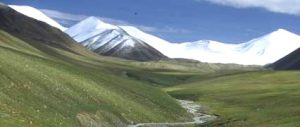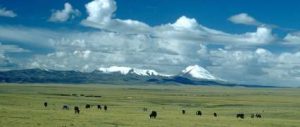Global climate change is one of the biggest challenges facing humankind in the twenty-first century. It is occurring at a time when China’s economic rise is leading to substantial environmental problems, combined with escalating demands on global resources. Many commentators have warned of impending economic collapse, rising social conflicts and large-scale public health disasters.
It is not only the modernisation drive in China that is at stake. The spillover effects across borders also present security concerns at the regional and global levels. From a security perspective, the emerging environmental crisis is generally cast in highly negative terms. Limited attention has been given to the question of whether China can adapt. In the case of climate change this is now an urgent task. On the Qinghai-Tibetan Plateau (henceforth the Tibetan plateau), climate impacts pose significant security risks for China and the Asia region. The ability to adapt is of critical importance to the future sustainability of the ecosystems as well as the millions of people they serve.
The Tibetan Plateau is the largest high altitude landmass on earth, covering an area of approximately 1.6 million square kilometres, equal to one-quarter of China’s land mass. As the largest fresh water reserve outside the polar ice caps it is also known as Asia’s water tower, or the “third pole”. For climate change, the plateau is the equivalent of the canary in the coalmine. Ice core records from the Dasuopu glacier in Tibet reveal that the last 50 years have been the warmest in 1,000 years. Over the past three decades, the average temperature has increased by almost 1 degree Celsius, and Chinese climate scientists predict a further temperature rise of between 2.0 to 2.6 degrees Celsius by 2050.
As a direct consequence, with the exception of the Karakorum, the glaciers that feed Asia’s great rivers – the Yellow, Yangtze, Mekong, Salween, Indus, Ganges, and Brahmaputra – have retreated by 196 square kilometres in the last 40 years. Data from the International Commission on Snow and Ice reveal that the Himalayan glaciers are shrinking faster than anywhere else and could totally disappear by 2035.
Glacial melt has dramatic adverse effects on biodiversity, people and livelihoods with long-term implications for water, food and energy security. It can also trigger a higher incidence of natural disasters – landslides, flooding and glacial lake outbursts – that can, in turn, lead to internal displacement and the destruction of critical infrastructure. Over the longer term, higher temperatures will increase flooding in the rainy season and reduce water in the dry season, thus affecting food production in the provinces downstream, as well as the livelihoods of over 1 billion people in China, India, Nepal and Bangladesh. Eventually water shortages will occur on a massive scale. The consequences for a region that is already highly prone to both floods and drought are dire. We are, in effect, facing a humanitarian catastrophe in the world’s most populous region.
Overall, the impacts of climate change will be greatest on poor communities that are least able to adapt. Tibetan pastoralists depend upon the grasslands for their survival, and climate change is leading to historically unprecedented pressures. For example, at the source of the Yellow River, at the centre of the Plateau, over one-third of the grasslands have transformed into semi-desert conditions. As environmental security analysts would predict, this is leading to increased environmental migration largely under the auspices of a government-controlled scheme to promote the regeneration of the grasslands. Recent studies have shown that the resettlement scheme is creating new social problems and the environmental benefits are uncertain. A major problem is that we still do not know enough about climate impacts on the grasslands. Field investigations are few and far between. What we do know is that a simple causal relationship between overgrazing and environmental degradation – a “Tragedy of the Commons”-style scenario – is misleading, precisely because it fails to take into account climate change. Placing disproportionate blame on Tibetan pastoralists also greatly undervalues indigenous knowledge and the important role that the original custodians of the land can play in climate adaptation efforts.
What is taking place on the Tibetan Plateau throws into sharp relief the complex relationship between the environment and security understood broadly to encompass the safety and well being of individuals as well as states. The interdependencies between environmental degradation, human well–being and regional security can only be addressed on the basis of a cooperative and people–centred approach. The critical question for policymakers is how to develop a regional response that can encourage a new strategic vision, while at the same time deliver positive results in the short term. Toward this end, I would like to offer four suggestions.
First, given the magnitude of the emerging environmental crisis on the Tibetan Plateau, developing an integrated regional map of the security risks involved is now an urgent task. An even-handed approach to anticipating risks entails a high level of research coordination and cross-sectoral analysis. The science needed to underpin these risk assessments is highly challenging and will require interdisciplinary collaboration, especially between scientists, ethnographers and security analysts. On this basis, current modelling work in the field of global environmental change can be supplemented with grounded analysis of potential harms at the local level.
Second, the region is seriously lacking relevant institutions to deal with the crisis. A consultative process for considering adaptation options and identifying collective responses does not, as yet, exist. What is needed is an inclusive dialogue mechanism that can bring together many stakeholders, including vulnerable communities at risk, corporations involved in infrastructure development and national and local governments. In general, regional security in Asia is concentrated at the state level. The involvement of corporations or non-governmental organisations is rare. This crisis may well provide the necessary catalyst for revitalising security cooperation by helping to dissolve the traditional boundary between the state and its people, which places a serious constraint upon the responsive capacity of states to deal with transnational security challenges.
Third, and somewhat optimistically, in addressing a bigger threat, the potential exists for climate change to unite divided communities on the Tibetan Plateau. Conflict resolution has long been an important motivating factor in designing institutions for managing resources. And placing conflict dynamics within a broader regional framework may well help to ease ethnic tensions. An expanded regional security vision offers an opportunity to resolve conflicts over access to resources, as well as ensure a fairer distribution of the benefits.
Fourth, and at a deeper level, the threat of large-scale environmental catastrophe reaffirms the need for a twenty-first century view of progress that moves imperatively beyond the nineteenth century model of nation-building based on the expansive exploitation of natural resources. Rather than simply a strategic buffer zone caught between the ambitions of great powers, the Tibetan Plateau could become a strategic conservation zone acting as a buffer against environmental catastrophe that threatens one-fifth of humanity.
Clearly, such a transformative approach would not be without its immediate economic costs, but as a guarantee of future Asian security it may well be a price worth paying. Industrialised countries have accrued a large debt for past malpractices and they are now seeking to make amends. For developing counties with limited adaptive capacities, the impacts of climate change are potentially devastating and, therefore, a wait-and-see policy is no longer an option. In some cases, environmental damage is irreversible: losses in biodiversity that provide essential services for human survival, such as the control of crop pests and carbon storage, are difficult to restore. The threat of massive ecosystem decline is, in part, a consequence of the failure to act. Hence there is now an urgent need to look to the future and build cooperation on the basis of regional collective responsibility, not only between states but also between peoples. If this does not happen, then the pessimistic scenarios put forward by security analysts, of wide-scale migration and conflicts over access to resources, may well result.
Dr Katherine Morton is a fellow in the Department of International Relations at the Australian National University. Her research interests include China’s international relations, environmental governance, and non-traditional and human security. She is currently conducting research on the impacts of climate change on the Tibetan Plateau and its implications for regional security.
The author would like to thank the Asia Pacific Review for granting permission to publish an adapted version of the original article titled ‘China and Environmental Security in the Age of Consequences’ Asia Pacific Review, 15:2, 2008: 52-67.
Homepage image by Daniel J Miller



